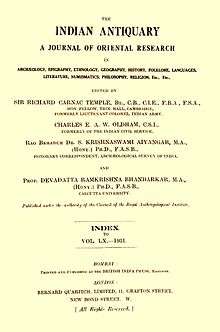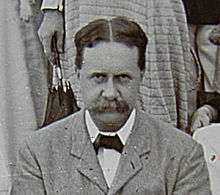The Indian Antiquary

The Indian Antiquary, A journal of oriental research in archaeology, history, literature, language, philosophy, religion, folklore, &c, &c, (subtitle varies) was an important journal of original research relating to India, published between 1872 and 1933. The journal was designed to enable the sharing of knowledge between scholars based in Europe and in India.[1][2] Volumes for 1925 to 1932 were "published under the authority of the Council of the Royal Anthropological Institute" (1933, not).
History
The journal was founded by the archaeologist James Burgess CIE as a private venture,[3] though no contributor or editor was ever paid for their work. On the contrary, the journal was a drain on the financial resources of the publishers.[4] Burgess was the first editor and he continued in that role until the end of 1884 when failing eyesight forced him to hand over to John Faithfull Fleet and Richard Carnac Temple.[3]
The late nineteenth century was marked by a great increase in the number of local historical societies in India and a similar increase in the number of Indians who could speak and write English, to the extent that by the 1920s the entire journal could have been filled with work by Indian contributors.[5] Despite the evident demand for the Antiquary, however, its first incarnation did not long survive Richard Temple's death in 1931 and it ceased publication in 1932. In 1922, Temple had published in Bombay a volume entitled "Fifty years of 'The Indian antiquary' ".
The New Indian Antiquary was published between 1938[6] and 1947, and the Indian Antiquary (described as the "third series") between 1964 and 1971.[7] (Volumes 14 to 62 of the original Antiquary were described as the "second series") The journal is no longer produced.
Content
The journal had an archaeological and historical focus, and in the late nineteenth century that naturally meant that epigraphy would be one of the principal subjects covered in its pages.[8] Indeed, the Antiquary was the premier source of European scholarship on Indian epigraphy until the twentieth century and the official Indian government journal of epigraphy, the Epigraphia Indica, was published as a quarterly supplement to the Antiquary between 1892 and 1920.[4]
The Antiquary was printed at Mazgaon, Bombay, by the Bombay Education Society and later the British India Press, but illustrations were produced in London to ensure the highest possible quality. A high standard of reproduction was essential so that scholars could work on the epigraphic illustrations at a distance.[9] Important inscriptions were deciphered by scholars like Georg Bühler and John Faithfull Fleet, Eggeling and B. Lewis Rice, Bhandarkar and Bhagvanlal Indraji, all based on illustrations in the Antiquary.[10] Many of those translations remain the definitive versions to this day.[8]
Over one thousand plates were included in The Indian Antiquary and the Epigraphia Indica over the first fifty years of publication, but having the illustrations produced abroad was not without its disadvantages. On one occasion during World War I, enemy action meant that expensive plates had to be sent from London three times before they reached Bombay safely.[9]
Another area where the Antiquary led was in recording folklore and folktales. It was the first to systematically record those of the Punjab[5] and the pioneering work on north Indian folklore of William Crooke and Pandit Ram Gharib Chaube was printed in its pages.[11]
Reprints
Some volumes of the journal were reprinted by Swati Publications, Delhi, 1984.
References
- ↑ Prospectus in The Indian Antiquary, Part 1, 5 January 1872, p. 1.
- ↑ "The Indian Antiquary" in The Antiquaries Journal, Vol. 2, No. 2, April 1922, p. 148.
- 1 2 Temple, Richard Carnac. (1922) Fifty years of The Indian Antiquary. Mazgaon, Bombay: B. Miller, British India Press, p. 3.
- 1 2 Temple, pp. 3–4.
- 1 2 Temple, p. 7.
- ↑ New Indian Antiquary South Asia Archive, 2014. Retrieved 30 May 2014.
- ↑ British Library catalogue search 29 May 2014.
- 1 2 Salomon, Richard (1998). Indian Epigraphy: A Guide to the Study of Inscriptions in Sanskrit, Prakrit, and the other Indo-Aryan Languages: A Guide to the Study of Inscriptions in Sanskrit, Prakrit, and the other Indo-Aryan Languages. New York: Oxford University Press. p. 219. ISBN 978-0-19-535666-3.
- 1 2 Temple, p. 6.
- ↑ History Archaeological Survey of India, 2011. Retrieved 30 May 2014.
- ↑ "Introduction" by Sadhana Naithani in William Crooke; Pandit Ram Gharib Chaube (2002). Folktales from Northern India. Santa Barbara: ABC-CLIO. p. 38. ISBN 978-1-57607-698-9.
External links
| Wikimedia Commons has media related to The Indian Antiquary. |
